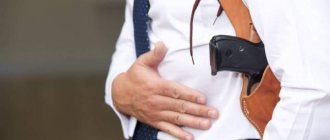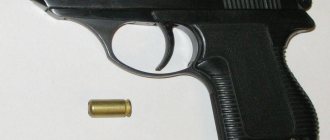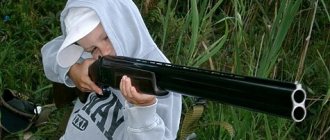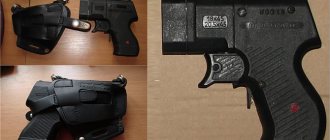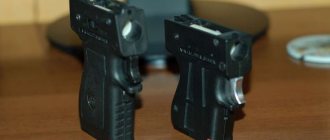If a citizen plans to use weapons for his protection, he may consider purchasing a traumatic pistol.
To do this, you must obtain permission from the police, and then follow the rules for carrying traumatic weapons provided by law.
What to do if you have difficulty opening the safe? You need to contact the Golden Key opening service for help; the company specializes in professional opening of contour safes, locks and doors. The Golden Key service is what you need if you want to minimize the risk of damage to your storage, maintain confidentiality and insure against a recurrence of the incident in the future.
What applies to traumatic weapons
It is one of the types of civilian weapons for self-defense. This determines its main task - protection.
This type includes firearms that have a limited degree of damage (abbreviated as OOOP) and use special cartridges with traumatic effects.
A special permit is required for:
- its application;
- storage;
- carrying with you.
The following categories of citizens have the right to wear it:
- some officials;
- military personnel;
- citizens for the purpose of self-defense;
- for shooting practice and training;
- persons for whom the state provides such a right because they need protection;
- workers of various professions whose tasks include hunting and protecting domestic animals from predators.
Technical features are determined at the legislative level.
These include:
- Limitation of muzzle energy. It cannot exceed 91 Joules.
- Only traumatic cartridges can be used. Even if it is technically possible to use cartridges of a different type, the owner does not have the right to do so.
- The purpose for which it can be used is self-defense. Use for other purposes is prohibited.
- You cannot load more than ten rounds into it at a time.
Why officials don't like "wasps"
“Traumatic weapons”, “traumatic weapons” are informal names for firearms of limited destruction (LDW). This term was introduced in 2011. OOOPs include pistols, revolvers and barrelless systems - “Osa”, “Strazhnik”, “Aegis”, using so-called traumatic cartridges as the main ammunition. Instead of a bullet, there is a light ball of dense rubber (for pistols and revolvers) or a heavy rubber bullet with a metal core (for barrelless systems).
The muzzle energy of a traumatic cartridge should not exceed 91 joules, and, say, the energy of a standard cartridge for a Makarov pistol is already 300 joules.
In Russia, the first traumatic pistol for the civilian market - BP-4 "Osa" - was certified in 1999. Since then, many officials of the Ministry of Internal Affairs and legislators have been waging war against this means of self-defense for citizens: opponents of “traumatics” are confident that it is too often used in fights, road conflicts and other circumstances that do not require self-defense.
Barrelless pistol "Osa"
Photo: Grigory Sysoev / RIA Novosti
Experts in weapons and self-defense admit that the non-lethal nature of rubber guns actually reduces the psychological barrier to using weapons. Let's say the owner of a hunting rifle understands that if he uses it, he can kill a person. And a non-lethal “rubber arrow” is often perceived as something frivolous - a “weapon for fighting” or “an extension of the fist” with which one can hit the offender without fear of getting hit back. The trouble is that the non-lethality of “traumatic” is relative. A shot from an Osa, for example, is comparable to a blow from a hammer. If you hit a person dressed in thick winter clothes in the chest, there will be no harm, but if it hits the temple or eye?
On the other hand, statistics show that the public danger of “trauma” is greatly exaggerated. In 2010, at the peak of the “anti-traumatic” hype, the deputy head of the public order department of the Ministry of Internal Affairs, police major general Leonid Vedenov, reported that in five years 65 people had died from traumatic weapons, about 485 more were injured (this includes cases of legal self-defense, illegal use , accidents and even suicide attempts). For comparison: in 2010 alone, according to the Ministry of Internal Affairs, more than 15.5 thousand murders and attempted murders were committed in the country, and in total 42 thousand people died as a result of criminal attacks.
How to obtain permission to purchase traumatic weapons
To do this, you need to contact the territorial police department at your place of residence. The issue of issuing such permits is handled by the licensing and permitting department.
Help 046-1
In some cases, it is required to take special courses on how to use it before receiving it.
First of all, you need to undergo a medical examination. As a result, you will need to obtain a certificate in form 046-1. Usually it costs 300 rubles.
Next, they collect a package of documents to contact the police.
Shots and distances
Self-defense weapons are designed to cause slight harm to the health of the attacker when shooting at soft tissues. As a rule, the zone of effective safe use of firearms with limited destruction is considered to be a distance of three to six meters. Beyond this distance, a hit may have no effect on the attacker, but closer than three meters it poses a real threat to life or health.
At effective safe shooting distances, a rubber bullet can hit muscle tissue to a depth of one and a half centimeters, causing superficial or penetrating wounds of soft tissue, depending on the density of the aggressor’s clothing. That is why it is necessary to shoot only at permitted places, without causing serious damage.
The procedure for obtaining a license for traumatic weapons
After the candidate has submitted the required package of documents to the police, he will be issued:
- Referral to special training courses in use.
- A receipt for payment of the state fee is provided. It will need to be paid. The amount for a license does not exceed 100 rubles.
- A direction to the local police officer is given.
In the first case, the exam will contain a test that will consist of ten questions. The verification procedure is as follows. A satisfactory result will be the correct answer to nine questions. You are given two attempts.
The first of them is free, the second is paid. If the candidate fails both times, he will have to additionally listen to several paid lectures and make a new attempt to pass the test.
The district police officer conducts a conversation and also inspects the housing at the place of registration. In particular, he will check the presence of a metal safe where the traumatic pistol should be stored.
After this, the issue of issuing a license will be considered within thirty days.
Rules for carrying traumatic weapons
When using, the following rules must be observed:
- A short-barreled gun may be kept with a loaded magazine, but without chambering a cartridge. A holster is used for carrying.
- The long barrel is worn uncovered.
- Prohibited from wearing in public places. An exception is provided only for the security guards who work there.
- Additional accessories may not be purchased or installed. This applies in particular to a silencer or optical sight.
- A drunk person may not carry or use it in any way.
- You can have no more than two units at your disposal.
- Can only be used when self-defense is necessary. In this case, the first shot must be fired into the air.
Which traumatic pistol is best to buy?
You need to decide on the size of the weapon. There are three categories here:
- Subcompacts . Weapons with the smallest dimensions and light weight, which greatly expands the variability of their carrying. As a rule, models of this class are maximally adapted for concealed carry - they have smooth shapes, no protruding parts, etc. This is an ideal choice for those who carry weapons 24/7. However, there is a drawback in the form of a modest magazine capacity. Also, due to its low weight, the compact barrel is prone to tossing.
- Standard . Golden mean. Convenient and ergonomic medium weight format. Still suitable for concealed carry, although to a lesser extent. Convenient for motorists. Magazine capacity is average.
- Full size . A weapon with large dimensions, a long barrel and impressive weight. The magazine capacity can be either large or medium. This product is purchased by people of large build, because... the previous options “do not fit” in your hand. You should not buy fullsize for aesthetic reasons - a kilogram of weight in a holster will very soon create an unpleasant reminder of yourself.
Otherwise, the injury is chosen based on personal preferences and financial capabilities. The only thing worth adding to the list of selection criteria is the availability and prevalence of spare parts.
Caring for your pistol
During the shooting process, carbon deposits appear, which adversely affect the performance of the entire mechanism as a whole. Although the rubber arrow model may be unpretentious, it is still worth keeping the device constantly clean - this is the key to its reliability in a critical situation. In this case, the cleaning procedure does not depend on the firing frequency. Weapons that are just sitting in a safe also need care, because... Over time, the lubricant of the components dries out or collects dust.
Workout
A weapon without the skill to use it will someday play a cruel joke against the owner himself. To operate the special equipment effectively, you will need constant practical training. This doesn’t mean you need to go to the shooting range every week—some of the basic skills can be learned even while at home.
The first thing you need to learn is the process of drawing the weapon from the holster and bringing it into combat. This skill must be honed until it becomes automatic. Moreover, for this you do not need anything other than the rubber arrow itself and a holster.
With firing, everything is somewhat more complicated. The specificity of self-defense involves firing at a dynamic approaching target. Accordingly, shooting at static targets is not the most effective type of training in this context. Ideally, you need to practice on special dynamic stands - these can be found in the Practical Shooting Federation and in other shooting organizations. But again, if there are no opportunities, you can create an impromptu idle workout.
Rules for the transportation of traumatic weapons
You need to know not only how to legally carry a traumatic pistol, but also how to transport it.
During transportation, the weapon is kept in a holster and loaded. But the cartridge should not be sent into the barrel.
If a police officer asks where he is being taken and why, he needs to give a detailed and reasonable answer.
It is strictly forbidden to transport while intoxicated.
Please note: you are allowed to transport up to five registered weapons and up to four hundred rounds of ammunition at a time.
The legislative framework
The main law regulating legal relations in the field of storing and carrying weapons is Federal Law No. 150.
We recommend reading: Categories of employees for which qualification requirements are established
It lists all types of weapons. However, traumatic pistols and rifles as such are not mentioned among them.
At the same time, the document mentions civilian self-defense weapons, which are equipped with cartridges that have a “traumatic effect.” This type of weapon is considered traumatic. In practice, it is customary to distinguish several categories of such devices:
- gas;
- firearms of limited damage (also referred to as OOOP).
- firearms without a barrel;
Trauma must meet several criteria simultaneously:
- Only traumatic cartridges are used;
- can only be used for self-defense;
- muzzle energy up to 91 J;
- the composition can include a maximum of 10 cartridges.
Despite the definition of “traumatic weapon,” these types of pistols and revolvers can not only cause bodily harm, but also kill a person when fired at close range into vital organs and parts of the body.
Therefore, the concepts of “traumatic” and “non-lethal” can mislead the consumer regarding the properties of such types of weapons.
Despite the fact that traumatism is indeed intended only for self-defense, this does not exclude the possibility of injury to a person or animal. Thus, from a technical point of view, the possibility (threat) of causing serious harm, including death, always remains.
Illegal carrying of traumatic weapons
If a citizen violates the existing wearing rules, then this is an administrative offense. In this case, you face a fine of 500 to 2000 rubles.
The right to both carry and store for a period of six months to twelve months can also be taken away.
If a person was armed while intoxicated, more serious sanctions are provided: a fine of 2,000 to 5,000 rubles or revocation of the permit for such a weapon for a period of one to two years.
In some cases, the result of such violations may be the confiscation of traumatic weapons.
Failure to comply with the demands of a police officer is punishable if a citizen has a traumatic pistol with him and is intoxicated. The representative of the law in this situation has the right to carry out confiscation.
In some cases, administrative arrest may be used.
It is worth noting: there are no criminal penalties for carrying without permission.
Wearing rules
Before you buy a traumatic weapon, you must first obtain the appropriate permit from the licensing department.
Immediately after purchase, the weapon must be registered, and its owner receives a license to carry and store traumatic weapons. However, the presence of such a document does not reduce the citizen’s share of responsibility either before the public or before the law. The rules for wearing, transporting and storing trauma equipment have been determined.
- All citizens, except those persons who are on the security staff of objects, are prohibited from wearing personal protective equipment in crowded places or in public places. To understand the rules, these two concepts are identical. These include: cafes, hospitals, schools, clubs.
- It is prohibited to install accessories on traumatic weapons. Thus, a silencer or an infrared night vision device will be illegal. It is understood that the traumatic weapon cannot be used as a weapon for hidden shooting.
- The number of weapons per citizen is very limited. If wearing a traumatic device is not transportation, then one person is allowed to carry only two units.
- A citizen who is drunk has no right to carry a traumatic weapon. It doesn’t matter at all whether he used it or not. The very fact of having a weapon is already considered a valid reason and grounds for initiating a criminal case.
The right to bear arms does not mean that they can be used whenever necessary. Trauma can be used if the life of a citizen or members of his family is truly in danger. In addition, he does not have the right to use weapons immediately to hit a target.
It is first necessary to loudly warn the attacker about the possibility of a shot, then fire one shot into the air and only then, taking into account that the distance to the target is at least one meter, use the weapon.
Otherwise, the citizen himself will become the accused; this often happens in practice.
Lost a traumatic pistol - what are the dangers?
First of all, you need to contact the police with a corresponding statement. In this case, you need to describe the situation in as much detail as possible.
Here it is important to convince the police as much as possible that your guilt is minimal. Losing while intoxicated or in violation of the rules of use is an aggravating circumstance.
The statement must be submitted to the police. It will be reviewed and the police officer will determine the degree of guilt. The punishment may be within the range of the specified administrative measures.
If you are late in contacting the police, the weapon may be used by strangers to commit a crime, which can lead to criminal liability.
Responsibility for violations of the rules for storing traumatic items
Responsibility for violations of the rules is administrative. For storage without a license, it will be the same as in other cases.
Responsibility for violation is provided for by the Administrative Code of Russia.
Article 20.8 states that if citizens violate storage rules, a fine of 3,000 to 5,000 rubles is provided. In this case, administrative arrest is possible for a period of five to fifteen days.
The full text of the article can be found at the link: https://www.consultant.ru/document/cons_doc_LAW_34661/9dbcd81b03e1f4963dfbe98bb8534b35dc88ee8c/.
Please note: Article 222 of the Criminal Code of the Russian Federation makes a reservation that the first three parts, where violation of storage rules are mentioned, do not apply to smooth-bore weapons.
Administrative liability occurs only in the absence of signs of a criminal offense. For example, if a smoothbore pistol was lost and a robbery was committed with its help, then its former owner can be considered an accomplice.
Additional Information
Previously in articles we talked about the rules that must be followed to acquire, own and carry an LLC, so in this article we will briefly recall them.
How to obtain permission to carry a traumatic weapon
To obtain permits for traumatic impact OOOP, you must start with a purchase license. To do this, you need to undergo a medical examination in accordance with forms 002-О/У and 003-О/У, and also obtain a license to purchase a traumatic pistol from local law enforcement agencies. After this, you can head to the nearest store that sells traumatic pistols. But having purchased it, along with a gun cabinet, you must, within two weeks from the date of purchase, apply to the LRRO to receive permits for the right to store and use the pistol for its intended purpose. Otherwise, it is prohibited to carry the injury with you.
Storing and carrying traumatic weapons without permission is prohibited by Russian legislation
Storage of traumatic weapons
According to the rules for storing weapons, it is necessary to purchase a weapons cabinet. The cabinet should consist of two sections - separately for the pistol itself, separately for ammunition. Only the owner must have the key to the cabinet. All this must be checked by a law enforcement officer before issuing you a permit to own and carry an LLC.
Transportation of traumatic weapons
According to the law, carrying and transporting OOOP are two different concepts. If wearing is allowed in a loaded state and in a holster of any type convenient for the owner, then transportation has its own limitations.
Transportation of a traumatic pistol is permitted only within the region of registration. To export an LLC to another region, it is necessary to obtain the appropriate permit from the regional office of the Russian Guard - otherwise the owner of the pistol risks receiving a fine for violating the rules of carrying.
Having received permission from law enforcement agencies, it is necessary to notify the carrier company that the owner has a traumatic pistol. The fact is that Russian Railways, and even air carriers, do not allow the transportation of weapons in combat-ready condition, in order to avoid terrorist attacks.
To avoid possible misunderstandings with carrier employees, it is recommended to arrive at the place of departure in advance in order to fulfill all the requirements of the carrier company.
Loss of a traumatic pistol
Losing a weapon is a familiar situation even to professional shooters. When a loss is discovered, the first thing to do is to immediately report the incident to law enforcement agencies. In this case, the owner will face a fair punishment, according to Article 20.8 of the Code of Administrative Offenses of the Russian Federation (a fine of up to 3 thousand rubles and temporary deprivation of a license). However, the apparent leniency of the punishment is very conditional - if a serious crime is committed with the help of a lost pistol, then the former owner may be charged with more serious penalties, depending on the severity of the crime committed.
You should not hide the fact that a weapon has been lost or stolen, and the sooner you report it, the better.

